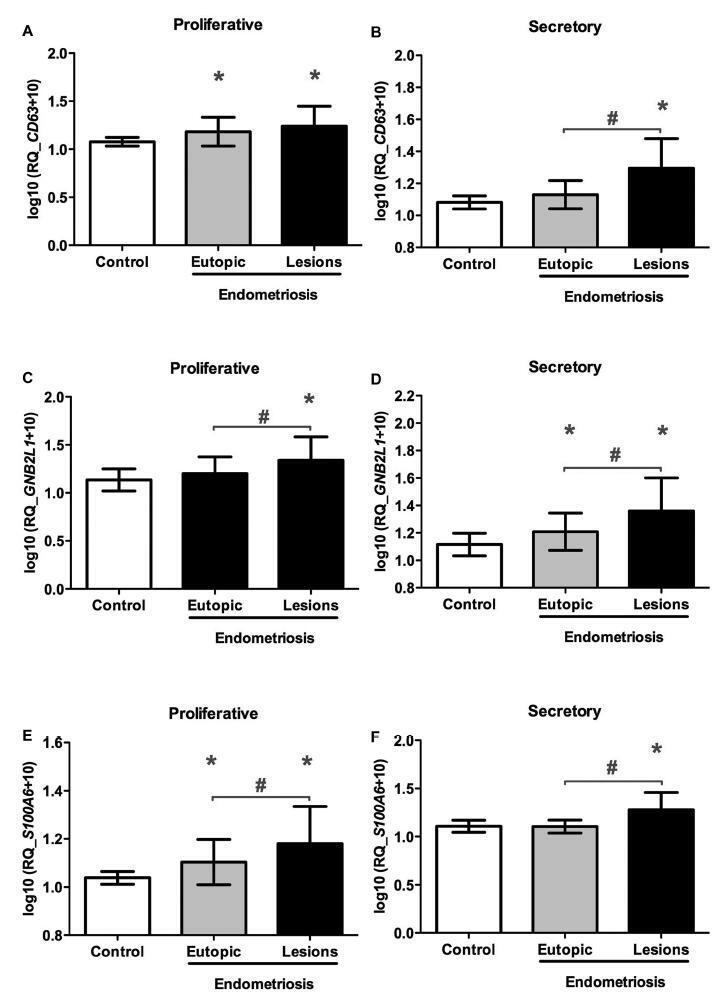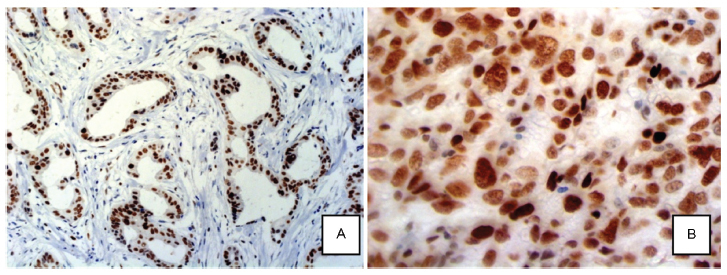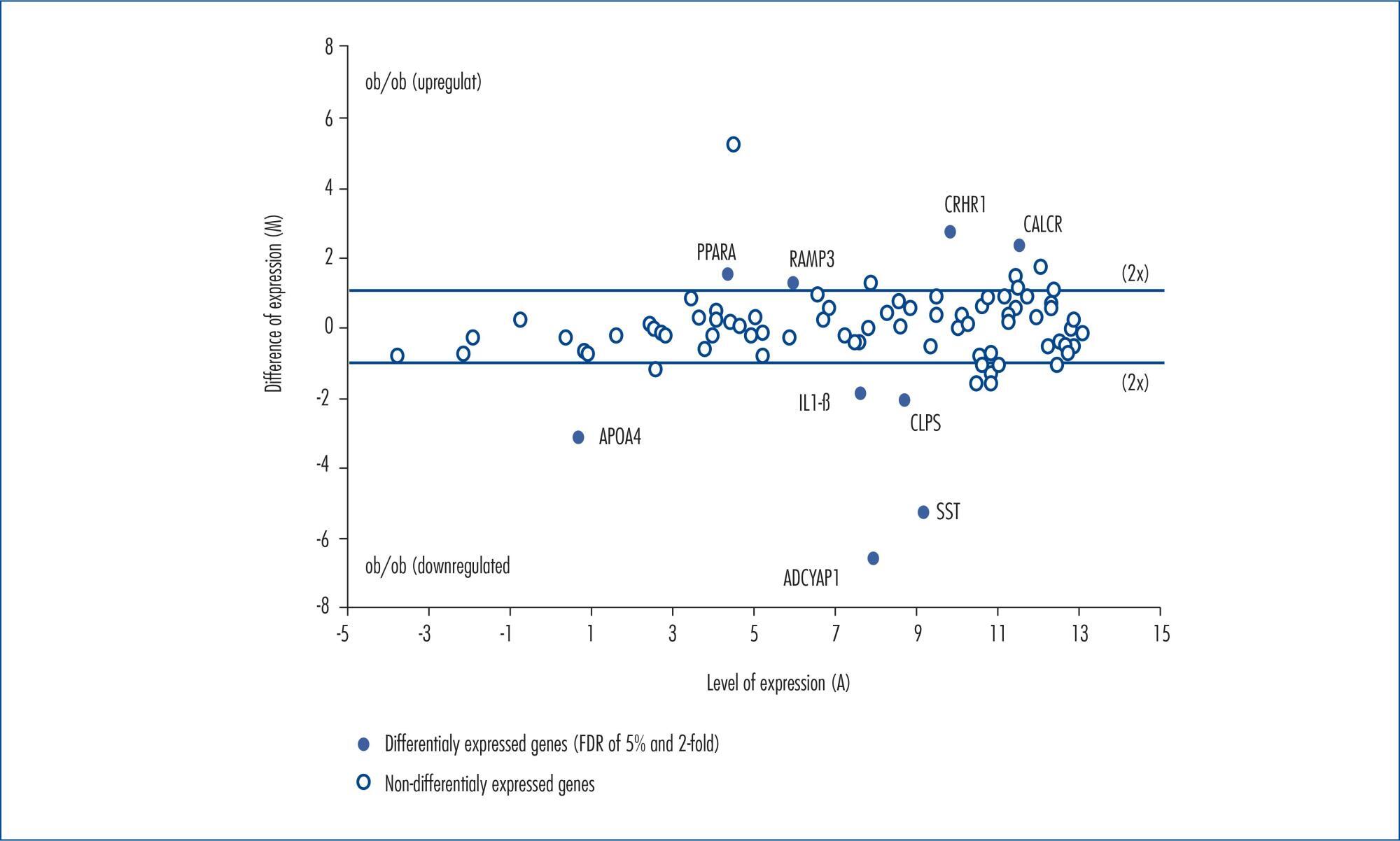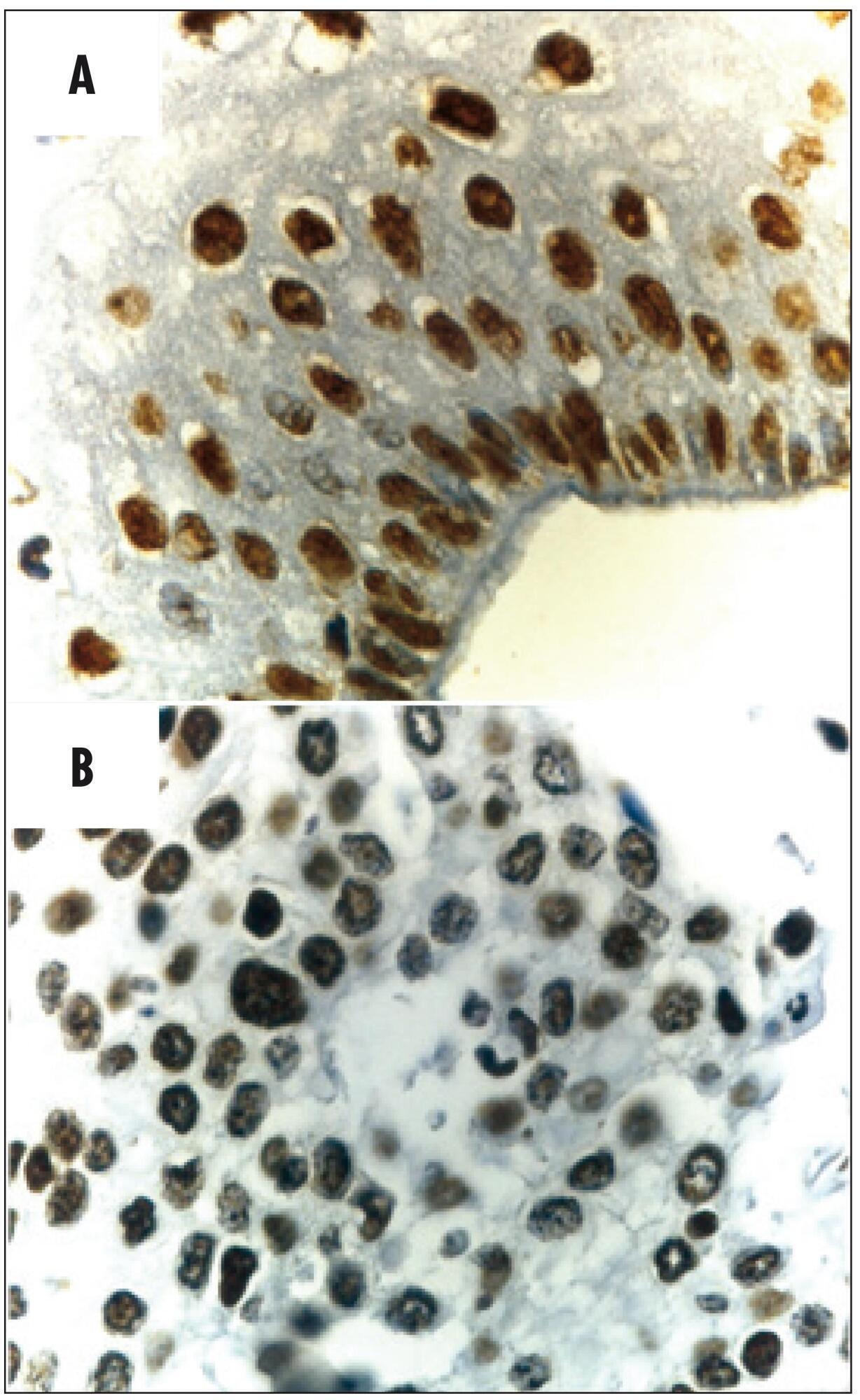-
Original Article
The Apoptotic, Angiogenic and Cell Proliferation Genes CD63, S100A6 e GNB2L1 are Altered in Patients with Endometriosis
Revista Brasileira de Ginecologia e Obstetrícia. 2018;40(10):606-613
10-01-2018
Summary
Original ArticleThe Apoptotic, Angiogenic and Cell Proliferation Genes CD63, S100A6 e GNB2L1 are Altered in Patients with Endometriosis
Revista Brasileira de Ginecologia e Obstetrícia. 2018;40(10):606-613
10-01-2018Views153See moreAbstract
Objective
The aim of the present study was to analyze the expression of the CD63, S100A6, and GNB2L1genes, which participate in mechanisms related to the complex pathophysiology of endometriosis.
Methods
A case-control study was conducted with 40 women who were diagnosed with endometriosis, and 15 fertile and healthy women. Paired samples of eutopic endometrium and endometriotic lesions (peritoneal and ovarian endometriotic implants) were obtained from the women with endometriosis in the proliferative (n = 20) or secretory phases (n = 20) of the menstrual cycle. As controls, paired endometrial biopsy samples were collected from the healthy women in the proliferative (n = 15) and secretory (n = 15) phases of the samemenstrual cycle.We analyzed the expression levels of the CD63, S100A6, and GNB2L1 genes by real-time polymerase chain reaction.
Results
An increase in CD63, S100A6, and GNB2L1 gene transcript levels was observed in the ectopic implants compared with the eutopic endometrium of the women with and without endometriosis, regardless of the phase of the menstrual cycle.
Conclusion
These findings suggest that the CD63, S100A6, and GNB2L1 genesmay be involved in the pathogenesis of endometriosis, since they participate in mechanisms such as inhibition of apoptosis, angiogenesis and cell proliferation, which lead to the loss of cell homeostasis in the ectopic endometrium, thus contributing to the implantation and survival of the tissue in the extrauterine environment.

-
Original Article
EZH2 Protein Expression and Tumor Response to Neoadjuvant Chemotherapy in Locally Advanced Breast Cancer
Revista Brasileira de Ginecologia e Obstetrícia. 2016;38(6):280-286
06-01-2016
Summary
Original ArticleEZH2 Protein Expression and Tumor Response to Neoadjuvant Chemotherapy in Locally Advanced Breast Cancer
Revista Brasileira de Ginecologia e Obstetrícia. 2016;38(6):280-286
06-01-2016Views162See moreAbstract
Introduction
Neoadjuvant chemotherapy (NAC) is the standard treatment for locally advanced breast cancer. However, some tumors will not respond to this treatment due to histological and molecular features. The protein EZH2 (enhancer of zest homolog 2) is a histone methyltransferase that is correlated with poorly differentiated breast carcinomas and aggressive tumor behavior.
Purpose
The present study evaluated the association between EZH2 expression and response to NAC, and its correlation with HER2 overexpression, estrogen and progesterone receptors (ER, PR) and Ki-67 proliferation index.
Methods
A total of 60 patients with locally advanced breast cancer treated with NAC were selected for this study. Twenty-three paraffin blocks had not enough material for tissue resection, and were not evaluated. A tissue microarray based in immunohistochemistry (IHC) analysis of EZH2 was performed for the remaining 37 specimens. Patients were divided into two groups based on response to NAC.
Results
EZH2 expression was significantly associated with markers of poor prognosis such as ER negativity (p = 0.001), PR negativity (p = 0.042) and high Ki-67 proliferation index (p = 0.002). High EZH2 expression was not correlated with the response to NAC.
Conclusions
Our data suggested that EZH2 protein expression may not correlate with the clinical response to NAC. Other studies with more patients are needed to confirm this observation.

-
Review Article
Common Dysregulated Genes in Endometriosis and Malignancies
Revista Brasileira de Ginecologia e Obstetrícia. 2016;38(5):253-262
05-01-2016
Summary
Review ArticleCommon Dysregulated Genes in Endometriosis and Malignancies
Revista Brasileira de Ginecologia e Obstetrícia. 2016;38(5):253-262
05-01-2016Views119See moreAbstract
Several authors have investigated the malignant transformation of endometriosis, which supports the hypothesis of the pre-neoplastic state of endometriotic lesions, but there are few data about the pathways and molecular events related to this phenomenon. This review provides current data about deregulated genes that may function as key factors in the malignant transition of endometriotic lesions. In order to do so, we first searched for studies that have screened differential gene expression between endometriotic tissues and normal endometrial tissue of women without endometriosis, and found only two articles with 139 deregulated genes. Further, using the PubMed database, we crossed the symbol of each gene with the terms related to malignancies, such as cancer and tumor, and obtained 9,619 articles, among which 444 were studies about gene expression associated with specific types of tumor. This revealed that more than 68% of the analyzed genes are also deregulated in cancer. We have also found genes functioning as tumor suppressors and an oncogene. In this study, we present a list of 95 informative genes in order to understand the genetic components that may be responsible for endometriosis' malignant transformation.
However, future studies should be conducted to confirm these findings.
-
Artigos Originais
Genetic analysis and cAMP measurement: comparison between lean and obese anovulating mice
Revista Brasileira de Ginecologia e Obstetrícia. 2015;37(4):186-191
04-01-2015
Summary
Artigos OriginaisGenetic analysis and cAMP measurement: comparison between lean and obese anovulating mice
Revista Brasileira de Ginecologia e Obstetrícia. 2015;37(4):186-191
04-01-2015DOI 10.1590/SO100-720320150005252
Views106See morePURPOSE:
To evaluate genes differentially expressed in ovaries from lean (wild type) and obese (ob/ob) female mice and cyclic AMP production in both groups.
METHODS:
The expression on messenger RNA levels of 84 genes concerning obesity was analyzed through the PCR array, and cyclic AMP was quantified by the enzyme immunoassay method.
RESULTS:
The most downregulated genes in the Obesity Group included adenylate cyclase-activating polypeptide type 1, somatostatin, apolipoprotein A4, pancreatic colipase, and interleukin-1 beta. The mean decrease in expression levels of these genes was around 96, 40, 9, 4.2 and 3.6-fold, respectively. On the other hand, the most upregulated genes in the Obesity Group were receptor (calcitonin) activity-modifying protein 3, peroxisome proliferator activated receptor alpha, calcitonin receptor, and corticotropin-releasing hormone receptor 1. The increase means in the expression levels of such genes were 2.3, 2.7, 4.8 and 6.3-fold, respectively. The ovarian cyclic AMP production was significantly higher in ob/ob female mice (2,229±52 fMol) compared to the Control Group (1,814±45 fMol).
CONCLUSIONS:
Obese and anovulatory female mice have reduced reproductive hormone levels and altered ovogenesis. Several genes have their expression levels altered when leptin is absent, especially adenylate cyclase-activating polypeptide type 1.

-
Artigos Originais
PTEN expression in patients with carcinoma of the cervix and its association with p53, Ki-67 and CD31
Revista Brasileira de Ginecologia e Obstetrícia. 2014;36(5):205-210
05-01-2014
Summary
Artigos OriginaisPTEN expression in patients with carcinoma of the cervix and its association with p53, Ki-67 and CD31
Revista Brasileira de Ginecologia e Obstetrícia. 2014;36(5):205-210
05-01-2014DOI 10.1590/S0100-7203201400050004
Views119See morePURPOSE:
To investigate protein expression and mutations in phosphatase and tensin homolog (PTEN) in patients with stage IB cervical squamous cell carcinoma (CSCC) and the association with clinical-pathologic features, tumor p53 expression, cell proliferation and angiogenesis.
METHODS:
Women with stage IB CSCC (n=20 - Study Group) and uterine myoma (n=20 - Control Group), aged 49.1±1.7 years (mean±standard deviation, range 27-78 years), were prospectively evaluated. Patients with cervical cancer were submitted to Piver-Rutledge class III radical hysterectomy and pelvic lymphadenectomy and patients in the Control Group underwent vaginal hysterectomy. Tissue samples from the procedures were stained with hematoxylin and eosin for histological evaluation. Protein expression was detected by immunohistochemistry. Staining for PTEN, p53, Ki-67 and CD31 was evaluated. The intensity of PTEN immunostaining was estimated by computer-assisted image analysis, based on previously reported protocols. Data were analyzed using the Student's t-test to evaluate significant differences between the groups. Level of significance was set at p<0.05.
RESULTS:
The PTEN expression intensity was lower in the CSCC group than in the Control (benign cervix) samples (150.5±5.2 versus 204.2±2.6; p<0.001). Our study did not identify any mutations after sequencing all nine PTEN exons. PTEN expression was not associated with tumor expression of p53 (p=0.9), CD31 (p=0.8) or Ki-67 (p=0.3) or clinical-pathologic features in patients with invasive carcinoma of the cervix.
CONCLUSIONS:
Our findings demonstrate that the PTEN protein expression is significantly diminished in CSCC.



